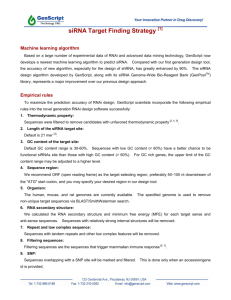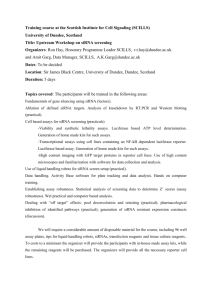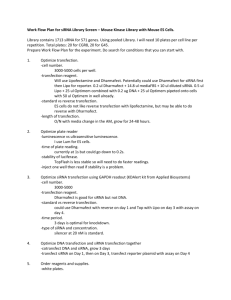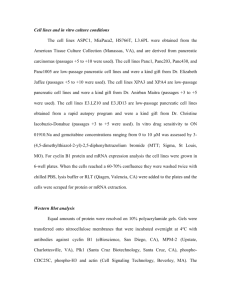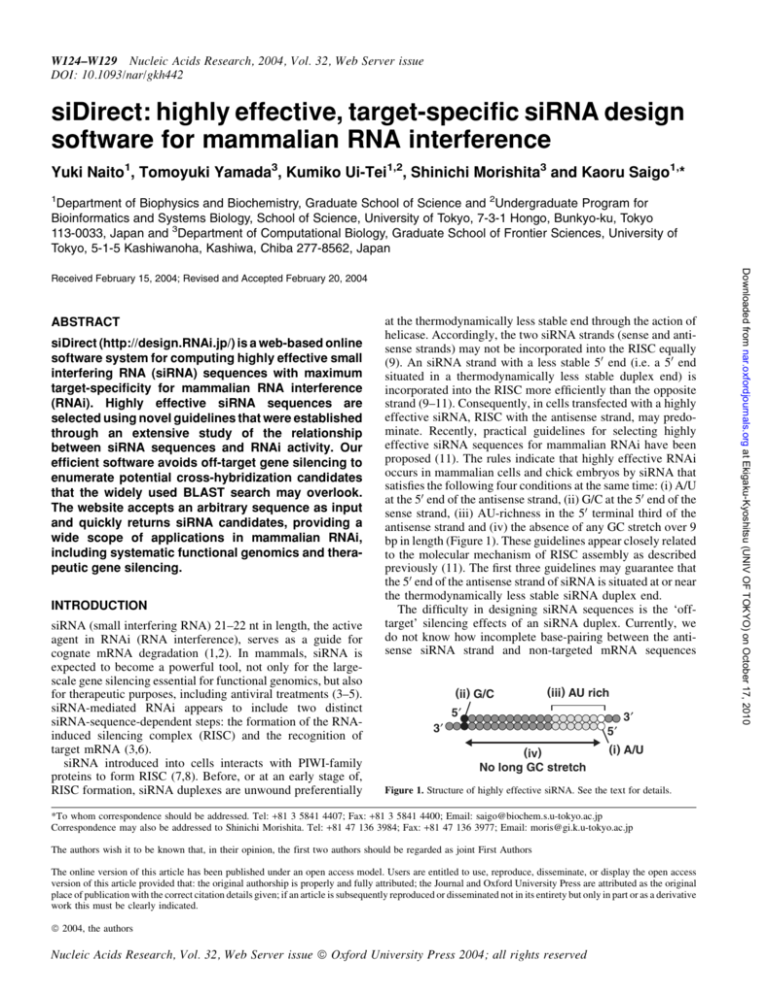
W124–W129 Nucleic Acids Research, 2004, Vol. 32, Web Server issue
DOI: 10.1093/nar/gkh442
siDirect: highly effective, target-specific siRNA design
software for mammalian RNA interference
Yuki Naito1, Tomoyuki Yamada3, Kumiko Ui-Tei1,2, Shinichi Morishita3 and Kaoru Saigo1,*
1
Department of Biophysics and Biochemistry, Graduate School of Science and 2Undergraduate Program for
Bioinformatics and Systems Biology, School of Science, University of Tokyo, 7-3-1 Hongo, Bunkyo-ku, Tokyo
113-0033, Japan and 3Department of Computational Biology, Graduate School of Frontier Sciences, University of
Tokyo, 5-1-5 Kashiwanoha, Kashiwa, Chiba 277-8562, Japan
ABSTRACT
siDirect (http://design.RNAi.jp/) is a web-based online
software system for computing highly effective small
interfering RNA (siRNA) sequences with maximum
target-specificity for mammalian RNA interference
(RNAi). Highly effective siRNA sequences are
selected using novel guidelines that were established
through an extensive study of the relationship
between siRNA sequences and RNAi activity. Our
efficient software avoids off-target gene silencing to
enumerate potential cross-hybridization candidates
that the widely used BLAST search may overlook.
The website accepts an arbitrary sequence as input
and quickly returns siRNA candidates, providing a
wide scope of applications in mammalian RNAi,
including systematic functional genomics and therapeutic gene silencing.
INTRODUCTION
siRNA (small interfering RNA) 21–22 nt in length, the active
agent in RNAi (RNA interference), serves as a guide for
cognate mRNA degradation (1,2). In mammals, siRNA is
expected to become a powerful tool, not only for the largescale gene silencing essential for functional genomics, but also
for therapeutic purposes, including antiviral treatments (3–5).
siRNA-mediated RNAi appears to include two distinct
siRNA-sequence-dependent steps: the formation of the RNAinduced silencing complex (RISC) and the recognition of
target mRNA (3,6).
siRNA introduced into cells interacts with PIWI-family
proteins to form RISC (7,8). Before, or at an early stage of,
RISC formation, siRNA duplexes are unwound preferentially
at the thermodynamically less stable end through the action of
helicase. Accordingly, the two siRNA strands (sense and antisense strands) may not be incorporated into the RISC equally
(9). An siRNA strand with a less stable 50 end (i.e. a 50 end
situated in a thermodynamically less stable duplex end) is
incorporated into the RISC more efficiently than the opposite
strand (9–11). Consequently, in cells transfected with a highly
effective siRNA, RISC with the antisense strand, may predominate. Recently, practical guidelines for selecting highly
effective siRNA sequences for mammalian RNAi have been
proposed (11). The rules indicate that highly effective RNAi
occurs in mammalian cells and chick embryos by siRNA that
satisfies the following four conditions at the same time: (i) A/U
at the 50 end of the antisense strand, (ii) G/C at the 50 end of the
sense strand, (iii) AU-richness in the 50 terminal third of the
antisense strand and (iv) the absence of any GC stretch over 9
bp in length (Figure 1). These guidelines appear closely related
to the molecular mechanism of RISC assembly as described
previously (11). The first three guidelines may guarantee that
the 50 end of the antisense strand of siRNA is situated at or near
the thermodynamically less stable siRNA duplex end.
The difficulty in designing siRNA sequences is the ‘offtarget’ silencing effects of an siRNA duplex. Currently, we
do not know how incomplete base-pairing between the antisense siRNA strand and non-targeted mRNA sequences
(ii) G/C
(iii) AU rich
5′
3′
3′
5′
(iv)
No long GC stretch
(i) A/U
Figure 1. Structure of highly effective siRNA. See the text for details.
*To whom correspondence should be addressed. Tel: +81 3 5841 4407; Fax: +81 3 5841 4400; Email: saigo@biochem.s.u-tokyo.ac.jp
Correspondence may also be addressed to Shinichi Morishita. Tel: +81 47 136 3984; Fax: +81 47 136 3977; Email: moris@gi.k.u-tokyo.ac.jp
The authors wish it to be known that, in their opinion, the first two authors should be regarded as joint First Authors
The online version of this article has been published under an open access model. Users are entitled to use, reproduce, disseminate, or display the open access
version of this article provided that: the original authorship is properly and fully attributed; the Journal and Oxford University Press are attributed as the original
place of publication with the correct citation details given; if an article is subsequently reproduced or disseminated not in its entirety but only in part or as a derivative
work this must be clearly indicated.
ª 2004, the authors
Nucleic Acids Research, Vol. 32, Web Server issue ª Oxford University Press 2004; all rights reserved
Downloaded from nar.oxfordjournals.org at Ekigaku-Kyoshitsu (UNIV OF TOKYO) on October 17, 2010
Received February 15, 2004; Revised and Accepted February 20, 2004
Nucleic Acids Research, 2004, Vol. 32, Web Server issue
sequences that match with three mismatches at the 5th,
10th and 14th positions, because the two sequences do not
share seven contiguous base matches, which is the shortest
word (consecutive nucleotides) that BLAST requires to
find hits.
GAAGGCAGTCCAGTGAAAT
ðNM_000014Þ
jjjj jjjj jjj jjjjj
GAAGCCAGTACAGAGAAAT
ðNM_002827Þ
METHODS
Moreover, BLAST with its default parameter values may fail
to notice best alignments with minimum number of mismatches when it receives such short sequences of 19 bases
as input. For instance, using BLAST, we searched the ‘nr’
database for ‘ACCGCAGTATATGGTTCTG’, a 19 nt
siRNA sequence candidate for NM_000014, and we received
the partial answer that the first 15 nt matched a substring of
NM_002864 at 100% identity. In fact, BLAST search overlooked the following best alignment with 18/19 matches.
Selecting highly effective siRNA sequences
ACCGCAGTATATGGTTCTG
ðNM_000014Þ
Highly effective siRNA sequences are selected using an algorithm based on new guidelines developed by Ui-Tei et al. (11;
Figure 1). Users can specify additional sequence conditions
required for proper transcription initiation and termination
(3,15) for designing short hairpin RNA, GC contents and
custom rules.
The simple condition of requiring AA at the beginning of
the target site is widely utilized to design siRNA sequences
(2). This rule, however, frequently misses effective siRNA
sequences that follow our four guidelines. Moreover, demanding AA at the beginning of the target site severely restricts the
selection of possible siRNA sequence candidates that minimize off-target silencing effects. We therefore did not incorporate this rule into our system.
jjjjjjjjjjjjjjj jjj
ACCGCAGTATATGGTGCTG
ðNM_002864Þ
Reduction of off-target silencing effects
The minimization of off-target silencing effects calls for the
selection of siRNA sequences that are guaranteed to have
some mismatches to all unrelated sequences. We here use a
rigorous specificity measure called the mismatch tolerance,
the minimum number of mismatches between the siRNA
sequence and any non-targeted sequence. For instance, an
siRNA sequence of mismatch tolerance three does not
match any off-target candidates with fewer than three mismatches. A higher mismatch tolerance of an siRNA sequence
indicates its high specificity in the presence of some
mismatches.
Exact mismatch-tolerance is costly to calculate, because it
demands searching the entire sequence database to check
whether individual siRNA oligos potentially cross-hybridize
with irrelevant sequences. The Smith–Waterman local alignment algorithm (16) may return accurate answers but is very
time-consuming to execute. In contrast, BLAST (17) is much
faster than the Smith–Waterman algorithm, but it may overlook significant alignments.
BLAST may overlook off-target candidates
The following alignment illustrates such an example where
BLAST fails to identify the similarity between two 19 nt
This search failure is due to the default parameter values of
BLAST. Since ‘match reward’ and ‘mismatch penalty’ are
respectively set to 1 and 3, the occurrence of one mismatch
demands at least four additional matches to extend the running
alignment. A partial solution to fully extend such alignments is
reducing the penalty of one mismatch, which, however, is
likely to output numerous, low homologous alignments with
off-target candidates.
To date, most existing websites for designing siRNA
sequences, such as siRNA Target Finder at the Ambion website, siDESIGN Center at Dharmacon, siRNA Target Finder at
GenScript (18), and Gene specific siRNA selector (19) use
BLAST to search for off-target candidates. We should bear in
mind that the limitations of BLAST in seeking optimal alignments may not minimize off-target silencing effects, as illustrated in the above example. In contrast, Qiagen utilizes
SSearch, a rigorous Smith–Waterman search which is computationally costly. It was the lack of efficient, accurate software
for enumerating potential off-target candidates that motivated
us to develop an efficient method for computing mismatch
tolerance (20).
Non-redundant sequence set of genes
Another major issue to solve was the generation of a nonredundant sequence set of genes for checking the target
specificity of siRNA sequences. Traditional non-redundant
sequence datasets, such as UniGene (21) and RefSeq (21),
are not suitable for this purpose, because alternative splice
variants in these datasets share common exons that bring
about duplication. Although searching for siRNA oligos on
common exons is valuable for simultaneous silencing of all
alternative splice variants, one siRNA oligo may hybridize to
any of the redundant exons, calling for duplicate elimination to
yield one representative exon so that siRNA oligos can be
properly designed. In addition, it is also necessary to consider
siRNA sequences that target the junction connecting two
Downloaded from nar.oxfordjournals.org at Ekigaku-Kyoshitsu (UNIV OF TOKYO) on October 17, 2010
affects silencing. Recent studies have shown that even a single
mismatch in the center of an siRNA can abolish silencing,
indicating the remarkable specificity of siRNA-based RNAi
that permits allele-specific gene silencing (12,13). In contrast,
Jackson et al. (14) showed that as few as 11 contiguous
matches between siRNA and an unrelated mRNA might
cause off-target silencing. These results motivated us to design
siRNA sequences that contain several mismatches to all nontargeted mRNA sequences.
This paper presents a new web-based online software system, siDirect, for selecting highly effective siRNA sequences
with maximal target-specificity for mammalian RNAi. The
siDirect algorithm incorporates the guidelines mentioned
above to favor efficient mammalian RNAi with a high success
rate, and it investigates all potential cross-hybridization candidates to avoid off-target gene silencing effects.
W125
W126
Nucleic Acids Research, 2004, Vol. 32, Web Server issue
Alternative splice variants on the same locus
Block of length 18
Non-redundant sequence set of genes
Duplicate-free exons
Figure 2. Generation of the non-redundant sequence set of genes from
alternative splice variants located on the same locus.
exons of a particular alternative splice variant. Thus, nonredundant sequences over exon–exon junctions together
with duplicate-free exons ought to comprise the non-redundant
sequence set of genes for checking target specificity (see
Figure 2).
Since such a database was not available, we created one.
First we aligned all the human RefSeq and Unique UniGene
sequences onto the human genomic sequences (hg16). For
each query sequence, we selected the best alignment that
had >90% coverage ratio and >85% match ratio. We retrieved
duplicate-free exons and sequences over exon–exon junctions.
However, since some sequences were not totally aligned to the
genomic sequence, due to sequence errors or the incompleteness of the genomic sequence, subsequences that failed to
match were added to the non-redundant sequence set. The
non-redundant sequence set of mouse genes was similarly
generated.
The major benefit of using the non-redundant sequence set is
that the mismatch tolerance of a ‘redundant sequence’, defined
as a substring of more than one exon on the same locus of the
genome, is likely to be higher in the non-redundant sequence
set than in the original set of human RefSeq and Unique
UniGene sequences. We will present the statistics below.
Selection of target-specific siRNA sequences from the
non-redundant sequence set
If an siRNA sequence is designed according to our four guidelines for effective sequences, the siRNA antisense strand is
thought to be incorporated into the RISC more efficiently than
the sense strand. This property may simply allow us to select
effective siRNA sequences by considering only the sense target, the complement of the siRNA antisense strand, within the
non-redundant sequence set. Thus, for siRNA sequences, we
define, in particular, the plus-strand mismatch tolerance as
mismatch tolerance calculated by using only the sense target
sequence. However, we cannot disregard the possibility that
the siRNA sense strand is also incorporated into the RISC and
causes off-target effects. Thus, it is more reliable to take both
Database maintenance
We plan to update our web server in response to major revisions to the human genome, the mouse genome, the RefSeq
Downloaded from nar.oxfordjournals.org at Ekigaku-Kyoshitsu (UNIV OF TOKYO) on October 17, 2010
Non-redundant sequences over exon-exon junctions
strands of siRNA sequences into consideration. The bothstrand mismatch tolerance is defined as the minimum number
of mismatched bases that allow the siRNA antisense or sense
strands to match a non-targeted sequence in the non-redundant
sequence set. There remains the question of how much the
mismatch tolerance of an siRNA sequence ought to be in order
to treat the siRNA sequence target-specific.
The non-redundant sequence set of human genes was analyzed to obtain a comprehensive understanding of mismatch
tolerance distribution of the 19 nt sequences that occur in
the non-redundant set. The statistics for 19 nt sequences in
Figure 3A shows that 9.5% are both-strand mismatch tolerance
three or four but there exist no sequences of both-strand mismatch tolerance five or more. The fraction doubles if plusstrand mismatch tolerance is recalculated as illustrated in
Figure 3B. From these results, we anticipate that effective
siRNA sequences of both/plus-strand mismatch tolerance
three or four can be designed for most of mRNA sequences,
and we define a sequence to be both-strand ( plus-strand,
respectively) specific if the both-strand (plus-strand) mismatch
tolerance is three or more. In reality, Figure 3C shows that, for
96.3% of mRNA sequences in RefSeq, at least one effective
both-strand specific siRNA sequence is designed. The fraction
increases to 97.7% if the plus-strand specificity is considered
instead.
Figure 3D verifies the usefulness of the non-redundant
sequence set, because in the original sequence set of human
RefSeq and Unique UniGene, most of redundant 19 nt
sequences are both-strand mismatch tolerance zero, while,
in the non-redundant sequence set, 10.7% of redundant 19
nt sequences are both-strand specific and are therefore mismatch tolerance three or more.
Figure 4 illustrates the flowchart of siRNA sequence selection by our system. First, our web server accepts an arbitrary
sequence or an accession number to retrieve its sequence.
Subsequently, the query is processed to calculate effective,
gene-specific siRNA sequences by searching the nonredundant sequence set for individual 19-nt sequences. To
accelerate the computational performance, we precompute
all the both/plus-strand specific siRNA sequences. This precomputation makes it possible to take just a couple of seconds
to return the complete list of both/plus-strand specific siRNA
sequences for a typical mRNA sequence (Figure 4B).
Care has to be taken to select an siRNA sequence since it
may cross-react with off-target candidates. Our web server
provides further information to examine the off-target silencing effects of a specific sequence. Clicking on the siRNA
sequence asks the system to search the non-redundant
sequence set for all the potential off-target candidates with
which the siRNA sequence might cross-react. This complete
search sounds to be computationally costly, but our algorithm
(20) is capable of processing this request in less than a second.
Subsequently, the server displays the alignment between each
off-target candidate and the siRNA sequence in order to depict
the locations of mismatches, which is useful in assessing the
off-target silencing potential (Figure 4C).
Nucleic Acids Research, 2004, Vol. 32, Web Server issue
A
B
70,000,000
Non-redundant
sequence set
60,000,000
RefSeq +
Unique UniGene
50,000,000
40,000,000
30,000,000
20,000,000
10,000,000
Number of all 19-nt sequences
80,000,000
70,000,000
Non-redundant
sequence set
60,000,000
RefSeq +
Unique UniGene
50,000,000
40,000,000
30,000,000
20,000,000
10,000,000
0
0
1
0
2
3
0
4
Both-strand mismatch tolerance
D
Number of redundant 19-nt sequences
C
100%
95%
90%
Plus-strand
specific siRNA
85%
Both-strand
specific siRNA
80%
1
2
3
4
5
Minimum number of siRNA candidates on a single mRNA
1
2
3
4
Plus-strand mismatch tolerance
12,000,000
10,000,000
Non-redundant
sequence set
RefSeq +
Unique UniGene
8,000,000
6,000,000
4,000,000
2,000,000
0
0
1
2
3
4
Both-strand mismatch tolerance
Figure 3. (A) The vertical axis is the number of 19 nt sequences of the both-strand mismatch tolerance shown in the horizontal axis. The solid line is the distribution for
the non-redundant sequence set. For comparison, the dotted line shows the distribution when all the RefSeq and Unique UniGene sequences are used without
removing any duplicates. Observe the dramatic reduction of redundant sequences of mismatch tolerance zero and the increases in the number of sequences of
mismatch tolerance one or two. (B) The statistical chart (A) is recomputed for plus-strand mismatch tolerance. Note that the number of 19 nt sequences of mismatch
tolerance three increases twofold. (C) The horizontal axis shows the requirement for the minimum number of effective, both/plus-strand specific siRNA candidates
on a single mRNA. The vertical axis is the fraction of qualified genes in RefSeq that fulfill the constraint in the horizontal axis. Note that the fraction of qualified genes
decreases severely when more both-strand specific siRNA sequences are designed, while the fraction decreases much more slowly when plus-strand specific siRNA
are designed. This indicates the usefulness of the plus-strand specificity for designing multiple effective siRNA sequences on a single mRNA sequence. (D) The
statistical chart in (A) is restricted to redundant 19 nt sequences and recalculated. This demonstrates that the non-redundant sequence set is indispensable for
evaluating mismatch tolerances of redundant sequences correctly.
database and the UniGene database, though it is inevitable that
such renewals will retract existing siRNA sequence candidates
or add novel ones.
DISCUSSION
In reality, for 2.3% of RefSeq sequences, we cannot design
effective, plus-strand specific siRNA sequences. NM_010447,
a mouse mRNA sequence, is a typical example. These cases
are difficult to handle automatically. One may attempt to relax
conditions on the target specificity by lowering the mismatch
tolerance to two, which is likely to yield numerous effective
siRNA sequence candidates, calling for some criteria for
selecting more target-specific sequences from these numerous
candidates.
Recall that Jackson et al. (14) stated that as few as 11 contiguous matches might cause off-target silencing. According
to this observation, one promising measure would be the
longest common factor of an siRNA sequence that is the length
of the longest contiguous matches between the siRNA
sequence and an unrelated sequence in the non-redundant
set. A larger longest common factor is likely to indicate
less possibility of cross-reaction with off-target candidates.
Another criterion would examine the positions of mismatches.
However, experimental confirmation of these criteria must be
extensively performed to be utilized in practice, and hence
we do not incorporate these measures into the current version
of our website. Therefore, our recommendation is that users
carefully select multiple siRNA sequences by investigating the
list of off-target candidates (Figure 4C) and perform experiments to monitor off-target effects caused by individual
siRNA sequences, even though the task is laborious.
Downloaded from nar.oxfordjournals.org at Ekigaku-Kyoshitsu (UNIV OF TOKYO) on October 17, 2010
Number of all 19-nt sequences
80,000,000
Fraction of qualified genes in RefSeq
W127
W128
Nucleic Acids Research, 2004, Vol. 32, Web Server issue
Downloaded from nar.oxfordjournals.org at Ekigaku-Kyoshitsu (UNIV OF TOKYO) on October 17, 2010
Figure 4. Flowchart of siRNA sequence selection by siDirect. (A) An arbitrary mRNA sequence is input. (B) Both/plus-strand specific precomputed siRNA
sequences are presented in front. Both-strand specific (plus-strand specific, respectively) sequences are colored blue (light blue) and are placed under the mRNA
sequence. Other siRNA sequences that meet the four guidelines of effective sequences are colored white. Clicking on an siRNA sequence displays the complete list of
off-target candidates. (C) The alignment between each off-target candidate and the siRNA sequence clarifies the locations of mismatches.
ACKNOWLEDGEMENTS
We thank S. Zenno and F. Takahashi for helpful discussions
and comments. The authors thank the anonymous referees for
their suggestions, which have been valuable to improve our
web server. This work was supported in part by funding from
the Special Coordination Fund for Promoting Science and
Technology to K.S., grants from the Ministry of Education,
Culture, Sports, Science and Technology of Japan to K.S. and
K.U.-T. and a Grant-in-Aid for Scientific Research on Priority
Areas (Grant #12208003) to S.M.
REFERENCES
1. Elbashir,S.M., Lendeckel,W. and Tuschl,T. (2001) RNA interference
is mediated by 21- and 22-nucleotide RNAs. Genes Dev., 15,
188–200.
Nucleic Acids Research, 2004, Vol. 32, Web Server issue
12.
13.
14.
15.
16.
17.
18.
19.
20.
21.
highly effective siRNA sequences for mammalian and chick RNA
interference. Nucleic Acids Res., 32, 936–948.
Brummelkamp,T.R., Bernards,R. and Agami,R. (2002) Stable
suppression of tumorigenicity by virus-mediated RNA interference.
Cancer Cell, 2, 243–247.
Miller,V.M., Xia,H., Marrs,G.L., Gouvion,C.M., Lee,G., Davidson,B.L.
and Paulson,H.L. (2003) Allele-specific silencing of dominant disease
genes. Proc. Natl Acad. Sci. USA, 100, 7195–7200.
Jackson,A.L., Bartz,S.R., Schelter,J., Kobayashi,S.V., Burchard,J.,
Mao,M., Li,B., Cavet,G. and Linsley,P.S. (2003) Expression profiling
reveals off-target gene regulation by RNAi. Nature Biotechnol., 21,
635–637.
Shi,Y. (2003) Mammalian RNAi for the masses. Trends Genet., 19, 9–12.
Smith,T.F. and Waterman,M.S. (1981) Identification of common
molecular subsequences. J. Mol. Biol., 147, 195–197.
Altschul,S.F., Gish,W., Miller,W., Myers,E.W. and Lipman,D.J. (1990)
Basic local alignment search tool. J. Mol. Biol., 215, 403–410.
Wang,L. and Mu,F.Y. (2004) A web-based design center for vector-based
siRNA and siRNA cassette, Bioinformatics (in press).
Levenkova,N., Gu,Q. and Rux,J.J. (2004) Gene specific siRNA selector.
Bioinformatics, 20, 430–432.
Yamada,T. and Morishita,S. (2004) Computing highly specific and noisetolerant oligomers efficiently. J. Bioinfo. Comp. Biol. (in press).
Wheeler,D.L., Church,D.M., Federhen,S., Lash,A.E., Madden,T.L.,
Pontius,J.U., Schuler,G.D., Schriml,L.M., Sequeira,E., Tatusova,T.A.
and Wagner,L. (2003) Database resources of the National Center for
Biotechnology. Nucleic Acids Res., 31, 28–33.
Downloaded from nar.oxfordjournals.org at Ekigaku-Kyoshitsu (UNIV OF TOKYO) on October 17, 2010
2. Elbashir,S.M., Harborth,J., Lendeckel,W., Yalcin,A., Weber,K. and
Tuschl,T. (2001) Duplexes of 21-nucleotide RNAs mediate
RNA interference in cultured mammalian cells. Nature, 411,
494–498.
3. Dykxhoorn,D.M., Novina,C.D. and Sharp,P.A. (2003) Killing the
messenger: short RNAs that silence gene expression. Nature Rev. Mol.
Cell Biol., 4, 457–467.
4. Stevenson,M. (2003) Dissecting HIV-1 through RNA interference.
Nature Rev. Immunol., 3, 851–858.
5. Gitlin,L. and Andino,R. (2003) Nucleic acid-based immune system:
the antiviral potential of mammalian RNA silencing. J. Virol., 77,
7159–7165.
6. Hannon,G.J. (2002) RNA interference. Nature, 418, 244–251.
7. Doi,N., Zenno,S., Ueda,R., Ohki-Hamazaki,H., Ui-Tei,K. and Saigo,K.
(2003) Short-interfering-RNA-mediated gene silencing in mammalian
cells requires Dicer and eIF2C translation initiation factors. Curr. Biol.,
13, 41–46.
8. Martinez,J., Patkaniowska,A., Urlaub,H., L€uhrmann,R. and Tuschl,T.
(2002) Single-stranded antisense siRNAs guide target RNA cleavage in
RNAi. Cell, 110, 563–574.
9. Schwarz,D.S., Hutvagner,G., Du,T., Xu,Z., Aronin,N. and Zamore,P.D.
(2003) Asymmetry in the assembly of the RNAi enzyme complex.
Cell, 115, 199–208.
10. Khvorova,A., Reynolds,A. and Jayasena,S.D. (2003) Functional siRNAs
and miRNAs exhibit strand bias. Cell, 115, 209–216.
11. Ui-Tei,K., Naito,Y., Takahashi,F., Haraguchi,T., Ohki-Hamazaki,H.,
Juni,A., Ueda,R. and Saigo,K. (2004) Guidelines for the selection of
W129




